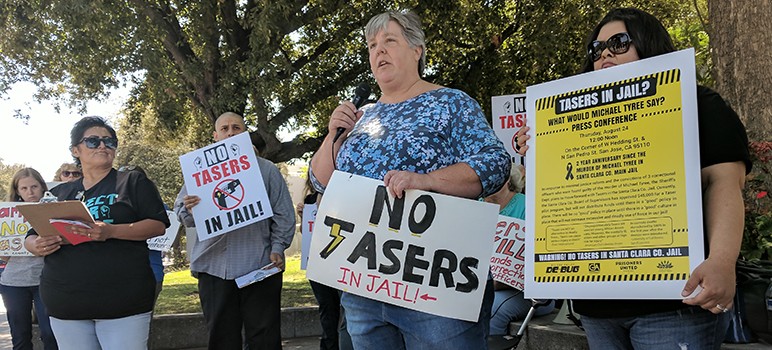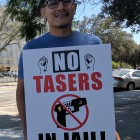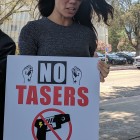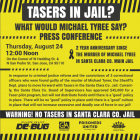Criminal justice activists marched today to protest Santa Clara County’s plans to arm jail deputies with Tasers. The assembly outside the Main Jail included former inmates, their friends and family and other reform advocates, who called the Sheriff’s Office proposal dangerous and politically motivated.
During the county’s budget hearings this past spring, Sheriff Laurie Smith asked for $45,000 to launch a pilot program to study the effectiveness of the electronic submission devices. The Board of Supervisors OK’d the request on condition that funds would be withheld until the Sheriff’s Office puts a sound policy in place.
But inmate advocates worry that Tasers could lead to further abuse in the county’s troubled jails. Organizers made a point of holding the rally just days away from the two-year anniversary of the death of Michael Tyree, a mentally ill inmates who was beaten to death by three jailers.
“Unfortunately, I don’t think the jails have a good track record,” said 34-year-old Jose Valle, a former inmate who works for social justice nonprofit Silicon Valley De-Bug and helped organize today’s rally. “As great as any of its policies are, they might not be good enough to prevent brutality. It didn’t take a Taser to kill Michael Tyree, it didn’t take a Taser for the many instances of violence by correctional officers. Why should we bring in another tool that will empower officers who aren’t complying with current excessive force policies? That doesn’t make any sense to me.”
About 30 people showed up to the protest at the corner of Hedding and North San Pedro streets, where Valle read a statement from inmates who worry about the potential for abuse if the county goes through with the Taser purchases.
“We are tired prisoners who have been concerned with our safety long before the tragedy of Michael Tyree,” Valle recited.
The statement went on to recount the brutal beating on Aug. 26, 2015, that left Tyree lifeless on the floor of his cell and left inmates all the more fearful for their own safety. It also described countless other beatings, Valle noted.
“This is first hand information physically witnessed by us, the prisoners,” he read. “Until this day, the screams still echo in our eardrums. The pictures and sounds of hearing thump after thump, punch after punch, still echo in our memories. The begging for mercy and the yelling of, ‘I am not resisting.’ What follows are the cover-ups, the justifying of their actions and the false reports. However, Michael Tyree is just a small portion of what we have been exposed to.”
Some protesters questioned the timing of the Taser request, which comes as Smith gears up for a re-election campaign against her former second-in-command, John Hirokawa. One woman held up a sign with a photo of Prince Swayzer III, a 38-year-old man who died in 2008 after San Jose police subdued him with a Taser.
Laurie Valdez, a jail reform advocate whose partner was fatally shot by police in 2014, said money for Tasers would be better spent on mental health treatment for inmates. She said that no amount of rules would prevent the kind of abuse that Tasers could enable.
“No policy is ever going to be good enough when it comes to violence,” Valdez said.
Valle agreed, adding: “There will be no good policy in place until there is a good culture in place that will not include excessive and deadly use of force in the jails.”
Sheriff’s spokesman Sgt. Reginald Cooks said the agency will take its time to craft a robust set of regulations to govern Taser use and expects to have a policy set in 2018 after various stakeholders have a chance to weigh in. He said the goal is to have a policy that “melds seamlessly” with the agency’s new use-of-force policies, which emphasize de-escalation and using as little force as necessary to manage inmates.
“The policy will not be dictated by any arbitrary timeframe,” Cooks said, “but rather, the policy will be forwarded to the Board of Supervisors when it accomplishes the goals of improving the safety and security of our facilities.”
Since the state began emptying its prisons by transferring inmates to county jails five years ago as part of sweeping reforms, local law enforcement agencies have had to deal with more sophisticated and violent felons, sheriff’s officials said. On top of that, Cooks said, reforms brought in the wake of Tyree’s death forced the jail to bump some inmates to a lower security classification to give them more out-of-cell time.
“On a regular basis, approximately 45 of the highest security level inmates can be interacting together,” Cooks said. “This places staff and inmates at an increase risk of serious injury.”
Last year, the Sheriff’s Office said it reported 528 assaults in the jails, 33 of which involved attacks by inmates on staff. In the budget hearings, Smith suggested that those could have been prevented if her jail deputies were armed with Tasers.
The Correctional Peace Officers’ Association (CPOA), the local jail deputy union, has long lobbied for adding Tasers to the arsenal to protect staff. In a letter to county supervisors, however, CPOA President Lt. Amy Le said the stun guns would protect inmates as well.
“Often the difference of a few seconds can mean the difference between life and death or lifetime disability for vulnerable inmates,” Le wrote in the Mary 16 letter. “We need more effective tools to protect inmates.”
Though Sheriff Smith primarily emphasized Taser use in the jails in the budget discussions, another big push for buying them came from the county’s Deputy Sheriffs’ Association, the union that represents the patrol deputies.
Sheriff Smith’s proposal drew immediate backlash from community groups that have been monitoring the jail after Tyree’s murder. In a letter to the county, Asian Law Alliance Director Richard Konda cautioned about the effect Tasers could have on inmates who are mentally and physically ill. According to a 2015 study, nearly half the inmates at the county’s two jails have been diagnosed with a mental illness and about 650 take psychotropic drugs every day.
“We believe any rush to bring Tasers to our jails without thorough research should be avoided,” Konda wrote in a letter also signed by former deputy public defender Aram James. “Not only are individuals with mental health concerns and prescription drug users more vulnerable to the lethal risk of Tasers, but inmates with heart issues and other physical limitations are equally vulnerable.”
Stun guns were invented in the 1970s, but saw resurgence in the early 2000s as Taser International—which has since changed its name to Axon Enterprise—aggressively marketed its more technologically advanced iteration of the tool to law enforcement. Though pitched as a non-lethal alternative instrument, a Reuters investigation found that, since 2000, more than 1,000 people have died after police used stun guns on them.
“We’ve developed a pretty good relationship with the sheriff’s department, with Laurie Smith,” Valle said. “That’s why I don’t understand this effort to purchase Tasers, which weren’t brought up once in any of the hundreds of reform policy recommendations after Tyree’s death. So I ask, ‘Why now? Why all of a sudden? How will this affect the community’s trust in our jails when it was already shaken?’”
This article has been updated.
- ‘No policy and no amount of money should be used to incite violence,” said Laurie Valdez, who lost the father of her children to police violence in 2014.
- “This sign makes the statement that the $45,000 could be better used on something else,” said Adrian Avila, a member of Silicon Valley De-Bug.
- “We do not want any more deaths in the jails,” said Jamie Foberg, a volunteer jail monitor. “Michael Tyree’s death was committed with the officers’ bare hands. We don’t need to arm the jail guards any further.”











Tough call, what’s more physically harming? 7 or 8 DOC officers sitting on your chest whacking at you with sticks, or a taser for a few seconds.
Alex I’ll take “Tasers” for $1000.
I know you were interested at one point, have you seen that the Mercury is doing a 6 part story on Kathy Atkins?
Yes, no tasers Bro! I’d much rather see inmates beaten shot or thrown down a flight of stairs. Are you kidding me?
Jails are a terrible place to be for both inmates and employees, When violence breaks out in a jail we owe the employees
the best possible defence. If that’s a taser, verse a gun or a stick I’ll take my chances with the taser if I was an inmate. Sending in a negotiator might just take way too long or get someone else killed. Who takes the blame when that happens?
If the employees are deliberately murdering the inmates then they will likely be joining their charges, something that needs to be pointed out to the people in blue.
They need these. Used to fire a bean bag thing, now they seem to shoot to kill. Back in the day they would
shoot in the leg? Guess it depends upon the situation.
I’d be interested to know the stance of the protesters pictured on other disabling weapons, specifically elephant guns.
The solution would seem to be something we have known about for quite awhile. Deputies should be given tranquilizer darts; capture sticks; and lassos. Perhaps correctional officers could also make use of those humane steel box traps that are used to live trap stray cats. Such traps could be baited with cigarettes; marijuana or gift certificates for tattoo parlors.
A course in zoology should be required training at the police academy, right along with all the diversity, sensitivity, implicit bias and all that other training that seems to be working so well.
How about some real innovation? Have deputies throw banana peels or hands full of ice cubes or marbles on the floor to stop the charge of an unruly inmate who only yearns to be helped; never-mind that he’s in there for molesting children; armed robbery or some act of mayhem or savagery.
If force options are taken away or innovation stifled, correctional officers will lose control of the jail and a “Lord of the Flies” social dynamic and mentality will take over the jail. The inmates ensure that there will be a “Saint Michael of Tyree” martyrdom in the jail every week.
Have each inmate throw their name into a hat, regardless of the crimes they have committed and regardless of their size or mental condition. Now, have someone pick a random number between 5 and 50, draw that number of names out of the hat then lock yourself in a small room with them after you’ve just had to tell them no more phone time; or their 10 minutes in the shower is up, get out; or no more food in the chow line, or after you’ve just stripped searched them over their protests.
Less worried about tasers (interesting that the enforcement side has been fighting for them for years now and been ignored, even after at least 2 shootings that may have been preventable) than I am about the training and use policy.
I’ve heard the recent Use of Force policy released by the sheriff is disastrous and has gaping holes leaving correction officers with concerns and the CPOA union board didn’t even read it and identify these issues before giving their stamp of approval. Not that it matters. We saw what happened with the FN 303 where training protocols weren’t followed, policy was negligible and a lieutenant ordered inappropriate use and may have contributed to the death of an inmate. Now we’re doing to introduce another tool which the sheriff will probably create an environment where it’s grossly misused due to lack of training and policy?
As for Le’s “few seconds” scenario & Smith saying the attacks on officers would stop – these are still pieces of equipment that will have to be securely stowed, this is not a street situation, where a deputy would just have the taser handy on their belt. While there are scenarios that may be ended a little quicker, Smith & Le are making a disingenuous argument to a public who is envisioning an officer who has their tools at hand for immediate use. They are using that more common conception of taser use to their advantage when it doesn’t apply here. It may protect lives a little easier, but not in the manner most people are going to think they will. These are the kinds of presentations that need to stop. The SO needs to be clear and honest about what kind of scenario these will be used in and what kind of training and access will be implemented. As we’ve seen over and over, the devil is in the details when it comes to Laurie Smith’s plans — mostly in the fact that there never are any details. Until that happens the Supervisors need to do as they did with the cell equipment – approve it, but hold it back until Smith has a compliant training and use policy that meets realistic standards and actually provide a safer environment.
I’m all for tasers in the appropriate circumstances, circumstances which mean Smith and her crony CPOA board aren’t able to endanger lives of officers and inmates simply to shove through something they think will gain them public approval.
To be fair, maybe Smith and Le fully intend to write and approve policy let lone deputies carry tasers around the jail rather than secured as done with most similar tools. Sadly it wouldn’t surprise me if that were their intent at this moment with the lack of general knowledge about safety they each appear to offer. Given that she leaves officers alone with up to 40 high risk inmates in a room, that should work out fantastic if an officer were to lose control of their taser, handing a free weapon to any inmate that wants one.
“Jose Valle, a former inmate who works for social justice nonprofit Silicon Valley De-Bug…”
So, a convict who still cavorts with known criminals… seems like a legit person to seek comment from. Well done Jen.
How about an actual investigative report on De-Bug? It would be too difficult (or take very long) to get the public records related to their members. Raj is always willing to speak on record, you could ask him to explain how past members have been killed in drug transactions and why current members continue to be involved in criminality.
It wouldn’t be a stretch to then see why De-Bug is so antagonistic with the forces that hold them accountable.